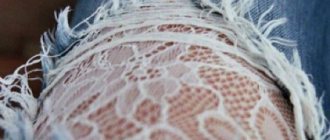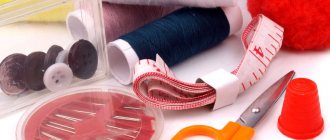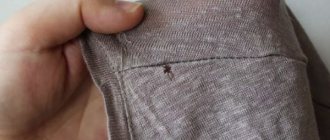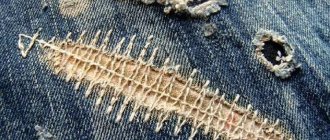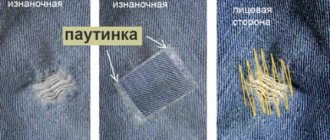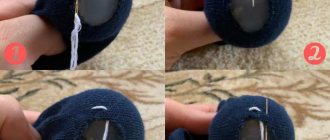Almost every person has such a necessary thing as jeans in their wardrobe. These are very comfortable and practical clothes and are quite wear-resistant. But even such durable fabric can tear or fray. what to do and how to quietly sew up jeans on the butt so as not to get into an unpleasant situation at the most crucial moment.
What to do if your jeans are torn on your butt
Any clothing gets old and worn out over time, jeans are no exception. They appear to have holes in various places, but there are all sorts of life hacks on how to sew jeans up on your butt without being noticed, so that you can wear them for several more years.
You can restore them by making an original designer item: apply a patch in the form of an applique, artistically sew it up, or darn it discreetly. Denim fabric is highly repairable, which cannot be said about many other materials.
To sew up torn jeans on the butt, you need to prepare some tools: threads, needles, scissors, the appropriate material chosen to match the color of the fabric, if you decide to make appliqués.
Main repair options:
- Application. A ready-made factory applique, or one independently cut from a material of any texture, is sewn onto the worn part.
- Patch. This is the application of a piece of material that best suits the structure and color.
- Decoration. This method is perfect for restoring children's clothing, but this option is also used for adults. The hole can be filled with embroidery threads, matching them by color. For kids, you can create cartoon characters or sew lace.
- Stuffing. Darning is done on a sewing machine. You can sew up your pants with strings, placing them closely together, thereby filling the hole with threads.
Attention!
If the tear in the jeans on the butt is insignificant, it is sewn up by connecting the edges to each other and cutting off the protruding threads. Small holes can be sealed with non-woven fabric. To do this, you need to cut out a piece of adhesive fabric of the required size and place it on the wrong side, connecting the edges to each other. Afterwards, simply iron the workpiece.
For any defect, you can select a specific repair option, taking into account the availability of materials and the nature of the hole
How to remove the thread if the loop breaks
To hide the thread and keep the product from tearing, in addition to the needle and hook, you will need a matching thread. You can fix the problem as follows:
- Using a wide-eye needle, bring the ends of the broken loop inside out.
- Try to connect the edges of the break with a piece of plain thread to create a loop.
- Align the crocheted thread with the hook.
- Securely secure the loop using thread and needle.
- Flatten and steam the fabric.
Thus, you will be able to quietly get rid of the problem and protect your favorite item from tears.
How to fix a hole in the butt of jeans
The ability to restore an item to its original appearance will depend on its damage. If you just need to sew up frayed jeans on your butt, you can do the repair yourself. The procedure itself consists of preparation (choosing a darning option: manual or machine, selection of material and tools), repair and the final stage (trimming excess fabric and threads, correcting flaws).
Correctly mending jeans on the butt using a machine is very simple; you only need basic skills. In addition, all the work can be done by a professional seamstress in a short time.
We recommend reading: How to remove polyurethane foam from clothes
How to sew jeans on the butt by hand
It is easier to repair jeans on the butt if the hole is quite large. It is not always possible to darn carefully; it is much more convenient to apply an applique or sew on a patch. You can manually restore things in the following ways:
- Latka. You need to choose a flap and threads that match the color and structure. Cut a patch slightly larger than the hole. Secure it with needles on the back side with the front side facing out. Sew a piece of fabric, making a classic seam, trim off the excess. On the outside, use stitches to pick up the frayed threads of the jeans. Iron the area where the patch is installed to give it a neat look.
- Application. Prepare a piece of material or select a ready-made applique. For symmetry and attractiveness, you can also make an applique on the second half of the jeans, which is intact. Fix a piece of fabric on top of the hole and fold its edges inward. Sew up the patch using a regular stitch and hide it with any decorative seam. After completing the procedures, iron to give a beautiful look.
- Darn. This method allows you to sew up holes that are at an oblique angle or in the shape of a cut line. Why you need to choose threads that match the color of the material. You need to apply stitches from one edge to the other, going back and forth. Then make seams perpendicular to those already made. This is done close to each other to create a mesh-shaped patch. The needle and thread are passed either from above the seam or from below. In this case, the main thing is to maintain the stitch sizes, making them the same.
In some cases, jeans tear at the butt due to the fact that a person accidentally sits on a nail. The resulting hole is quite large; it will not be possible to sew it up unnoticed. In this case, you can attach a pocket here, then the defect will be hidden and the jeans will be more functional.
If you carefully sew up a hole, it is almost invisible
How to beautifully sew jeans on the butt using a sewing machine
You can carefully sew jeans on the butt using a sewing machine. The main thing is to choose threads that match the color of the material and be able to work with the equipment. In this case, the darning area will be almost invisible, and the pants will last for a long time. There are several options for fixing a hole - patching and gizmo.
Darning is called darning on a sewing machine using additional fabric. Why do you need to fix the deformed area in a hoop? On the back of the jeans, place a material matched to the color under the hole. Sew the hole from the outside along the seams using the reverse motion of the sewing machine. You need to make the stitches as closely as possible, filling the space of the hole.
A patch is a classic machine-sewn patch. For this you will additionally need denim fabric, threads chosen to match the color and a piece of adhesive patch slightly larger than the hole. Main stages of work:
- Cut the patch a little larger than the hole and apply it to the defect from the inside.
- Place adhesive fabric over the patch with the sticky part facing the jeans.
- Place another piece of fabric on top.
- Moisten everything with water and iron it.
- From the outside, along the edge of the hole, go in a “zigzag” pattern with a wide stitch, going in 1 mm.
- After completing the procedure, pull the cut threads to the inside and tie them into knots. Excess fabric is cut off and the patch is ironed with a hot iron.
Important! If you need to sew jeans on the butt along the seam, then a sewing machine is best suited.
To do this, you need to sew the edges of the hole on the reverse side with a fine stitch. Then cut out a strip of adhesive fabric, apply it to the seam and glue it with a hot iron. Upon completion of the process, make a seam from the outside using threads that sew the seams on the product.
After any repair of jeans, the repaired area must be ironed
What temperature to choose
As a rule, any product has a label with care requirements. A special symbol will tell you how much you need to heat the iron so as not to spoil anything.
If there is no label, consider the type of fabric:
- Cotton - 180–220 °C;
- Linen - 215–240 °C;
- Viscose - 150–180 °C;
- Wool - 160–170 °C;
- Polyester - 140–155 °C;
- Silk - 140–165 °C;
- Mixed - choose the temperature according to the type of fabric for which it is lower.
Useful tips
Even after studying all the options for how to fix jeans on the butt, many questions and difficulties may arise during the process. But it’s better not to sew up holes, but to use simple recommendations to ensure that your pants last a long time and don’t fray:
- Care of clothing must be carried out taking into account the instructions on the tag. You need to wash it separately from other items or with the same denim items. Before putting them in the washing machine, they need to be turned inside out. It is undesirable to subject clothes to frequent washing, as this leads to rapid thinning of the material. It is recommended to wash jeans on a delicate cycle, in warm water and without using bleaching agents. In this case, things will last longer, and there will be no need to sew up holes in the butt.
- You need to buy jeans that fit exactly. Very narrow or, conversely, wide ones wear out faster.
- During repairs, it is necessary to take into account the nature of the deformation. If the holes are small, it is recommended to seal them with plaster. Large holes can be masked with a patch. Secure any cracks that appear with adhesive material. The main thing is to make a decorative seam on the outside, otherwise the base will soon peel off.
- Drying is done naturally by hanging clothes on the dryer. You should not do this in a washing machine.
We recommend reading: How to fold jackets compactly: winter and autumn, with and without a hood
Principles and recommendations
The first thing to remember is don't rush. Only professionals can iron men's trousers quickly and correctly. Before ironing the creases on your trousers, you need to prepare to clean up the work surface and prepare the necessary tools:
- Iron with steam function to make the arrows perfectly straight and high-quality ironed.
- Ironing board. If it is not there, then you can use any table. The surface should be covered with a cloth made of dense material.
- Container with water. It will help wet your pants during the procedure.
- Sprayer for humidification.
- Gauze.
The soleplate of the iron must be free of dirt. Be sure to wipe it down or clean it before ironing.
An important condition is compliance with the specified temperature conditions.
To properly iron pants with arrows, it is recommended to adhere to the following rules:
- Ironing clean trousers. Under no circumstances should there be stains. Otherwise, due to high temperature, they will remain on the fabric forever.
- It is necessary to study the tag on the product. In addition to the composition, the temperature and mode for ironing are also indicated there.
- Before ironing your trousers, you should clean them of lint. To do this, use a special brush or roller with adhesive tape.
- There should be no items in your pockets.
Return to contents
"Long-lasting" arrows
1st option. The classic way to fix the arrows for a long time is to go over them from the inside with a slightly damp piece of laundry soap, and then iron the folds from the front side.
2nd option. Table vinegar helps to secure the folds. 1 tbsp. l. Dilute the 9% solution in 1 liter of water, moisten the gauze and iron the trouser legs through it.
3rd option. Prepare paste for trousers with arrows: 3 tsp. Dilute starch in a small amount of cold water and pour into 200 ml of boiling water while stirring. Then after 2-3 minutes remove from heat and cool. Lubricate the fold lines from the inside with a thin layer of the resulting paste. Wait until it is completely dry and iron the arrows from the front side.
Why are they wiped?
Jeans is a high-strength fabric, but a number of reasons provoke rapid abrasion of the threads. This problem is more typical for natural denim without synthetic impurities.
Features of the figure
Features of the body structure lead to increased tissue friction:
- close placement of the hips;
- excessive muscle development in athletes.
In some people, the thighs are in close contact and constantly rub when walking, leading to thinning of the material.
Gait features
The way your legs are positioned when walking contributes to the wear of denim - the fabric wears out equally for those who mince with small steps and waddle.
Material quality
The lightest and thickest denim fabric wears out. Thick denim rubs more slowly, but creases in the wrong size cause wear. The presence of synthetics protects the material well - the presence of elastane or polyester increases the wear resistance of jeans.
Restlessness
Jeans rub not only when walking - for those who like to fidget in their chairs, the wear process is ongoing.
Overweight
Those who are overweight most often suffer from holes between their thighs, especially if they are constantly growing. The seams stretch, the fabric is constantly under stress not only from friction, but also from tension.
Temperature
It is extremely important to determine the optimal iron temperature. Graphic information about the maximum permissible heating is located on the product label. But if it is not preserved, you need to remember:
- silk, satin, twill should be ironed at a gentle temperature of up to +100°C with an iron without steam, and through dry gauze;
- viscose and knitwear can withstand heating up to +120°C and steaming;
- Woolen trousers with creases can be ironed at a temperature not exceeding +120...+130°C;
- for thick cotton fabric that can be moistened, the temperature can be set to +170°C;
- suiting fabrics, on which folds often last a long time, are not afraid of +200°C.
It is extremely important to determine the optimal iron temperature to successfully iron a particular fabric.
How to iron trousers with creases?
There is nothing more unsightly than the sight of wrinkled trousers with a hint of former creases. A self-respecting person would never appear in public wearing such clothes. Moreover, putting this important attribute in order is a simple procedure and takes only a few minutes. If only you know how to properly iron trousers with creases.
Tidying up trousers with creases is a simple procedure and takes just a few minutes.
Algorithm of actions
It is important to know how to iron trousers with creases correctly. The main principle: first, almost all the details of the item are ironed from the inside out. It is turned right side out when the arrows begin to be ironed.
These steps can be performed in different ways. For example, immediately iron both pant legs laid on top of each other, ironing them on one side and then on the other side. But you can process each trouser leg separately.
- The trousers turned inside out should be put on the narrow part of the board and the waistband and lining should be steamed.
- Then move on to the pockets. To prevent traces from appearing on the front side, place a towel, a piece of cardboard or a sheet of thick paper.
- Then finish the side seams. We must not forget about periodically moistening the gauze, even if the iron has a steam function.
- Then fold the product so that the legs are exactly aligned on the sides and bottom edge, and iron them, not reaching the arrows. You can secure the trouser legs with pins, bobby pins, needles or metal stationery pins. But if you have to iron on an uneven surface, the fabric can still warp.
- Finally, the most important thing: how to make creases on trousers with an iron. It is necessary to fold the product so that the fold lines are exactly aligned with the darts coming from the waistband. The darts in the front are the beginning of the arrows, this is approximately 7 cm from the waistband.
- When ironing the fabric, the trouser legs will not move if you do not slide the iron over them, but gradually move it forward along the entire fold line, then back.
The main principle of ironing trousers with arrows: first, almost all the details of the item are ironed from the inside out.
Men's and women's trousers
For women, trousers are available in various models: tapered, straight, cropped. They have a lot of darts, thanks to which the clothes gracefully fit the figure. Due to the significant difference in styles, ironing women's products is easier.
How to iron trousers for ladies? You need to lay them so that not only the fold lines are connected, but also the darts. You can use pins to secure things. After one trouser leg has been ironed, it is turned away and heat treatment of the second trouser leg begins.
The principle of ironing men's trousers is the same as women's trousers. The only difference is that such models have practically no darts. When ironing men's trousers with creases, you have to constantly monitor the location of the seams so that they do not move. First you should iron the most difficult parts: belt, pockets, codpiece with zipper, and only then proceed to the creases.
Where is the web used?
Glue web for fabric is widely used in repairs and making clothing from fabric:
- Connecting parts of the collar and cuffs.
- Processing the bottom of the trousers.
- Connecting the bead and hem instead of shuttle stitching using a blind machine, since the model does not provide for the application of thread seams.
- Elimination of cuts in fabric material.
- Connecting a patch or appliqué to the surface of an item.
- Side seal.
Gossamer tape is not used on everyday clothes, as it is often washed, which adversely affects the quality of gluing, resulting in detachment of the joint.
Beautiful patches
If a small hole is easy to eliminate using ordinary methods, then with a large defect you will have to use your creative abilities. The easiest way to carry out repairs is with thermal stickers. They are sold at any craft store.
Various decorative stickers are selected according to the style of clothing. By the way, this way you can not only mask damage, but also create original clothes. For children's dresses there are patches with hearts, for boys' T-shirts and pants - with images of cartoon characters.
Bursting upholstery on a sofa or chair seat is also masked with patches. You won’t be able to sew up holes on the thinnest tulle unnoticed, but thermal stickers with floral patterns, butterflies, etc. will come to the rescue.
Do not rush to get rid of the product if its defect can be repaired. A neat stitch or a beautiful appliqué will bring the item back into service.
Jacket patches are an easy way to repair outerwear that has holes or scratches. To mask defects, scraps of leather, raincoat fabric or other synthetic materials are used. Depending on the method and place of attachment, different types of patches are used - adhesive, stripes, hot-melt adhesive and internal ones, which are hemmed from the wrong side. Modern jackets are full of finishing elements, so small holes can be covered with braid, appliqués, zippers, bias tape and other decor.
Frozen tights
A very popular method is to freeze a new pair of tights overnight. So, all you need to do is wet your new tights with water. Then pack them in a bag and place them in the freezer overnight. The next morning, remove the bag from the freezer in advance and let the tights thaw and dry. This procedure is done only once, after purchasing tights. When they are dry, you can put them on and wear them as usual. Freezing makes the fibers stronger, and the chance of getting creases in your tights is minimized.
Hair fixation spray
Hairspray has approximately the same properties as nail polish. And, most likely, most women will have a bottle of varnish. So, if you find a crease on your tights, just spray a small amount of polish on the beginning and end of it. The varnish will slightly glue the spreading fibers together, and the arrow will stop creeping further. However, try not to spray it too close to the product. Because in this case, stains will inevitably result, which will ruin the entire appearance of the already damaged tights.
Soap to the rescue
Another very interesting and useful way to help stop creases in tights is to use soap. However, it is only suitable for light-colored tights. You will need dry bar soap.
Just rub the resulting arrow with a bar of soap and you can go about your business. This technique dries the fibers of the fabric, and the product is stored for some time.
Preserving tights with varnish
Back to regular hairspray again. It will be useful not only in cases where arrows have already formed on nylon tights, but also before this unpleasant moment, as a preventive measure. So, take a new pair of tights and hang them outdoors with clothespins. It is best to do this on the balcony. Shake the can of nail polish so that the contents become a homogeneous consistency and begin spraying the tights. Please note that the varnish layer must be thin. Once you have applied it on both sides, let the tights air dry slightly. After a couple of minutes you can put them on. This method is the most effective, but you need to distribute the varnish evenly to avoid streaks.
Technique for manually sealing a round hole
To seal a round through hole, you need to prepare the following tools and materials:
- a piece of denim fabric of the same color as the item being repaired;
- threads matching the color;
- needle;
- scissors;
- iron.
Work to eliminate the hole is carried out in the following order:
- Cut a patch from the flap that is larger in diameter than the hole.
- Place the patch with the front side to the wrong side of the jeans and sew around the circumference with a small seam, no more than 1 mm on the front side. If possible, you should try not to pierce the fabric all the way through, but rather grab individual threads from the surface of the wrong side.
- Place the holey area with the sewn patch on a hard surface, slightly stretching the fabric. In this case, the front side of the jeans should be located on top, and the patch on the bottom.
- On the front side of the hole, make frequent parallel stitches along the grain thread. The needle entry and exit points should be at some distance from the edge of the hole, into undamaged areas of the material. To avoid the edges bunching up, make a small loop at the end of each row.
- After the entire hole is closed with long longitudinal stitches, the same stitches should be laid in the transverse direction, intertwining them with the threads of the first row.
- It is necessary to take into account the direction of weaving of threads on the restored fabric. When weaving diagonally, the stitches should also be laid diagonally.
- After completing the repair, iron the repaired area first from the wrong side and then from the front side.

